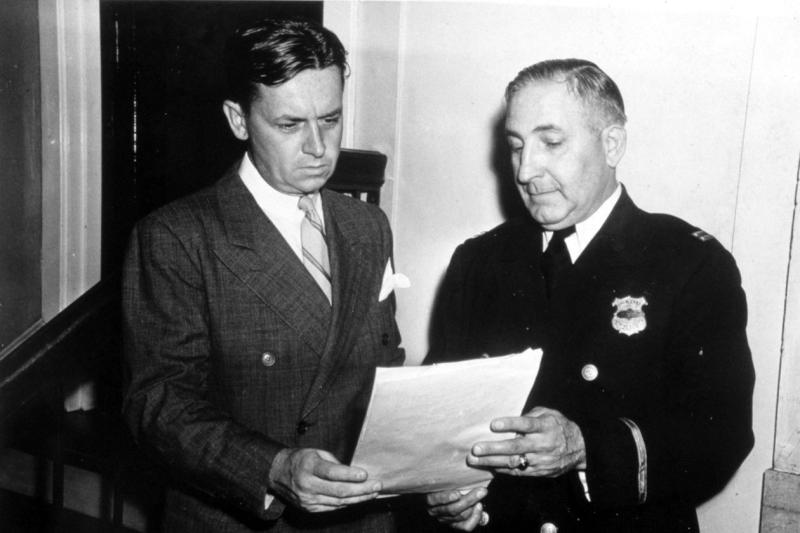'Eliot Ness and the Mad Butcher' Review: An Untouchable Second Act - WSJ
By: Tom Nolan (WSJ)



Moviegoers of a certain age will remember Eliot Ness—the upright law-enforcement figure who battled corruption and organized crime from the 1920s to the ’40s—as portrayed by a tough-talking Kevin Costner in Brian De Palma’s 1987 movie “The Untouchables.” Television viewers from an even earlier era will recall Ness depicted by the stern-faced Robert Stack in the ABC series (1959-63) of the same name. But the real-life Ness, as revealed in Max Allan Collins and A. Brad Schwartz’s “Eliot Ness and the Mad Butcher,” was less the hard-boiled hero of popular culture than a humane and forward-thinking lawman as interested in preventing crime as in punishing it.
The Chicago-born Ness (1903-57) came to prominence as a Prohibition agent in the Windy City, doing battle with Al Capone and other bootleggers as head of his own hand-picked squad of agents. His men were dubbed the “Untouchables” for their refusal to accept payoffs or gratuities. As a friend observed of the incorruptible lawman: “Honesty amounted to almost a fetish.”
The government put Capone behind bars in 1932 via the prosecution of a tax-evasion case, but the work of Ness and his men was central to establishing the extent of the mobster’s criminal activities. With Capone out of the picture, the Untouchables were disbanded, and Prohibition ended soon after. Ness, a nationally known figure (his physical and professional image inspired Chester Gould’s comic-strip police hero Dick Tracy), looked beyond Chicago for new opportunity. He found it in Cleveland, the site of his next significant successes—but also of the disturbing case that gives Messrs. Collins and Schwartz’s book its title.
Ness was named Cleveland’s director of public safety in 1935 and was put in charge of the city’s police and fire departments. He found the cops to be sloppy, uncooperative and demoralized. Once more he formed his own discrete unit of Untouchables to weed out incompetent and corrupt officers and hire smart new ones. “Intelligence,” he counseled, “must supplant brutality.”
But even Ness was stumped trying to apprehend the “torso murderer” responsible for a series of ghoulish killings, in which parts of dismembered and beheaded corpses were strewn about the woods and dumpsites of Kingsbury Run, one of the city’s poorest areas. “The mystery of the headless dead” drew national and international attention. In Germany, the Nazi press mocked America’s inability to apprehend the “Mad Butcher of Kingsbury Run.” With no witnesses and sometimes no way even to identify victims—and with advanced forensics techniques far in the future—police were stymied.
By 1938, the authors write, “the Butcher had become the subject of the largest manhunt in Cleveland’s history.” Thousands of citizens wrote and called the cops with worthless tips. “The investigators, after years of fruitless searching, grew desperate, pursuing ever more eccentric lines of inquiry.” At last a few tantalizing leads brought an alcoholic and mentally disturbed doctor named Francis Sweeney to the attention of the detectives.
Ness and his crew subjected the 44-year-old Sweeney—who had shown signs of psychosis and had been verbally and physically cruel—to judicially inadmissible polygraph examinations that convinced all present of his guilt. Still, despite an abundance of circumstantial indicators, Ness had no hard evidence. Complicating matters was the man’s being a cousin of a local congressman, a vocal Ness critic. Prosecution was not an option. Ness handled the matter privately, helping to arrange Sweeney’s commitment to a mental hospital. Sweeney, who was institutionalized for much of the rest of his life, sent a series of bizarre and taunting postcards to Ness through the mid-1950s.
Though Ness was sure that the killer had been caught and dealt with, he couldn’t officially close the case and so swore himself and his men to secrecy. The public was left with the impression that the culprit might still be at large. The case of the Mad Butcher, with its unsatisfying non-finale, fits a bit awkwardly into Messrs. Collins and Schwartz’s wider narrative. In the latter stages of their book, the authors ably follow Ness through an unsuccessful foray into city politics and a disappointing business career. But given this work’s title and its subtitle—“Hunting America’s Deadliest Unidentified Serial Killer at the Dawn of Modern Criminology”—one sometimes gets the feeling of two different books uneasily hitched.
That said, the authors have done Ness justice. It’s discouraging to learn that a man who refused a fortune in bribes died $9,000 in debt. Shortly before his fatal heart attack at the age of 54, he finished work on the memoir that would revive and romanticize his reputation and bring his third wife and their adopted son a modicum of income.
Messrs. Collins and Schwartz, in this, their second deeply researched book about Ness, don’t gloss over their subject’s failings and blind spots, but they do show that he tried harder than many to leave the world a better place. His “signature achievements in Cleveland—fighting juvenile delinquency, reorganizing the police department, promoting traffic safety—stemmed from a deep well of humanity and compassion,” they write. Now more than ever, the authors conclude, Ness’s name “should remind us of the rigorous standards he brought to law enforcement—professionalism, competence, honor, and decency—and a determination to make everyone safer by addressing the systemic root causes of crime.”
Mr. Nolan reviews crime fiction for the Journal.

Who is online
37 visitors

